instrument panel CHEVROLET CAMARO 1996 4.G Owners Manual
[x] Cancel search | Manufacturer: CHEVROLET, Model Year: 1996, Model line: CAMARO, Model: CHEVROLET CAMARO 1996 4.GPages: 402, PDF Size: 21.38 MB
Page 21 of 402
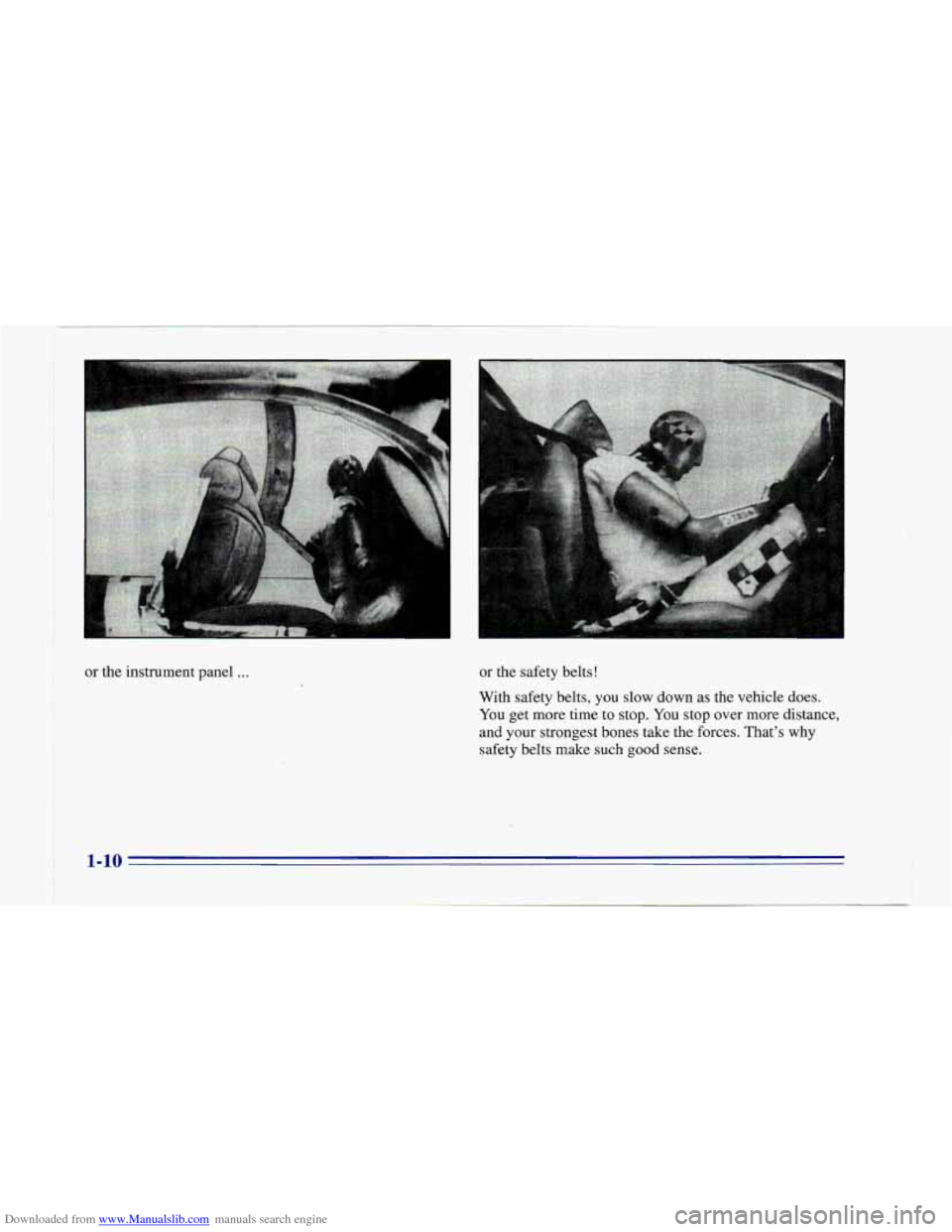
Downloaded from www.Manualslib.com manuals search engine or the instrument panel ... or the safety belts!
With safety belts, you slow down as the vehicle does.
You get more time to stop. You stop over more distance,
and your strongest bones take the forces. That’s why
safety belts make such good sense.
Page 32 of 402
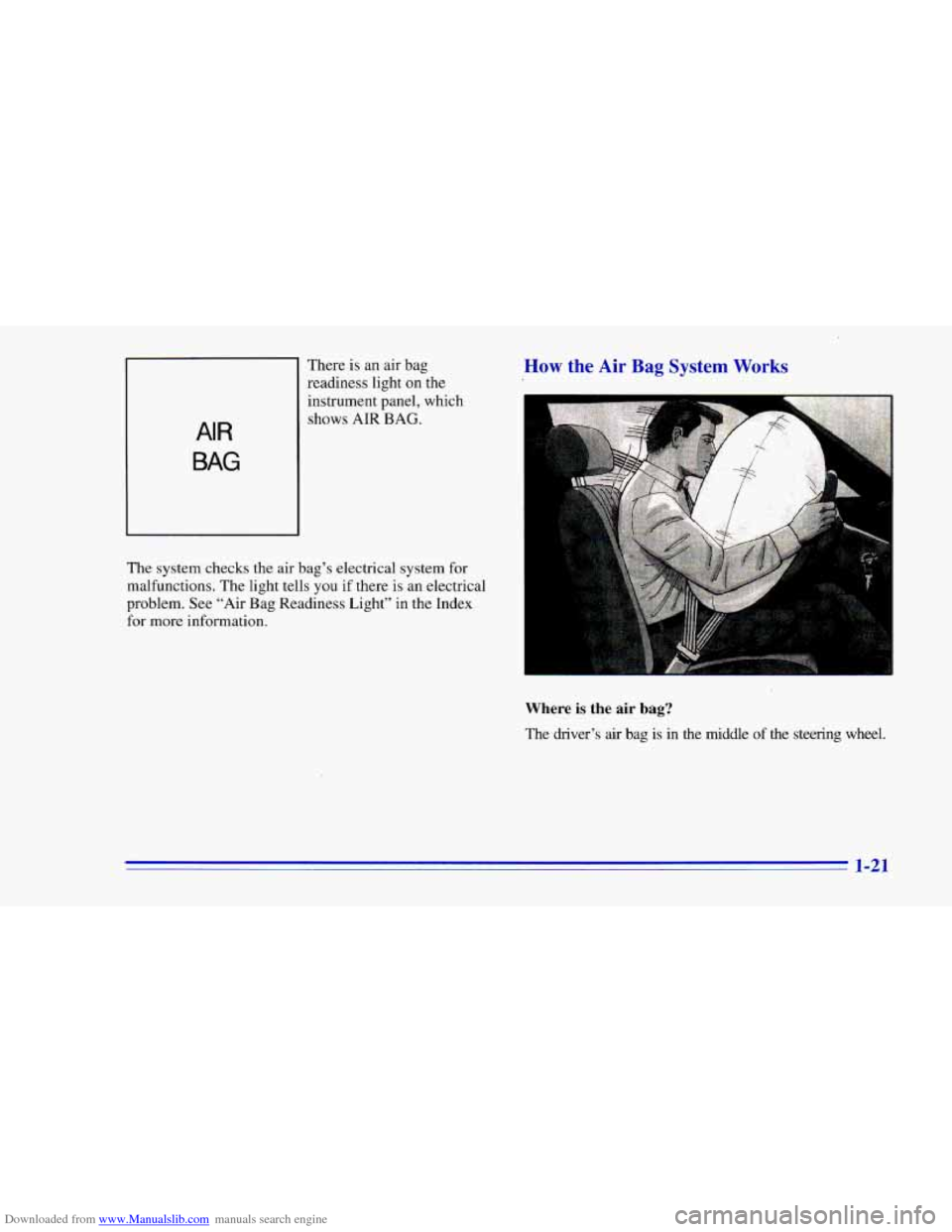
Downloaded from www.Manualslib.com manuals search engine There is an air bag
readiness light on the
instrument panel, which
AIR
BAG
shows AIR BAG.
The system checks the air bag’s electrical system for
malfunctions. The light tells you if there is an electrical
problem. See “Air Bag Readiness Light” in the Index
for more information.
How the Air Bag System Works
Where is the air bag?
The driver’s air bag is in the middle of the steering wheel.
Page 33 of 402
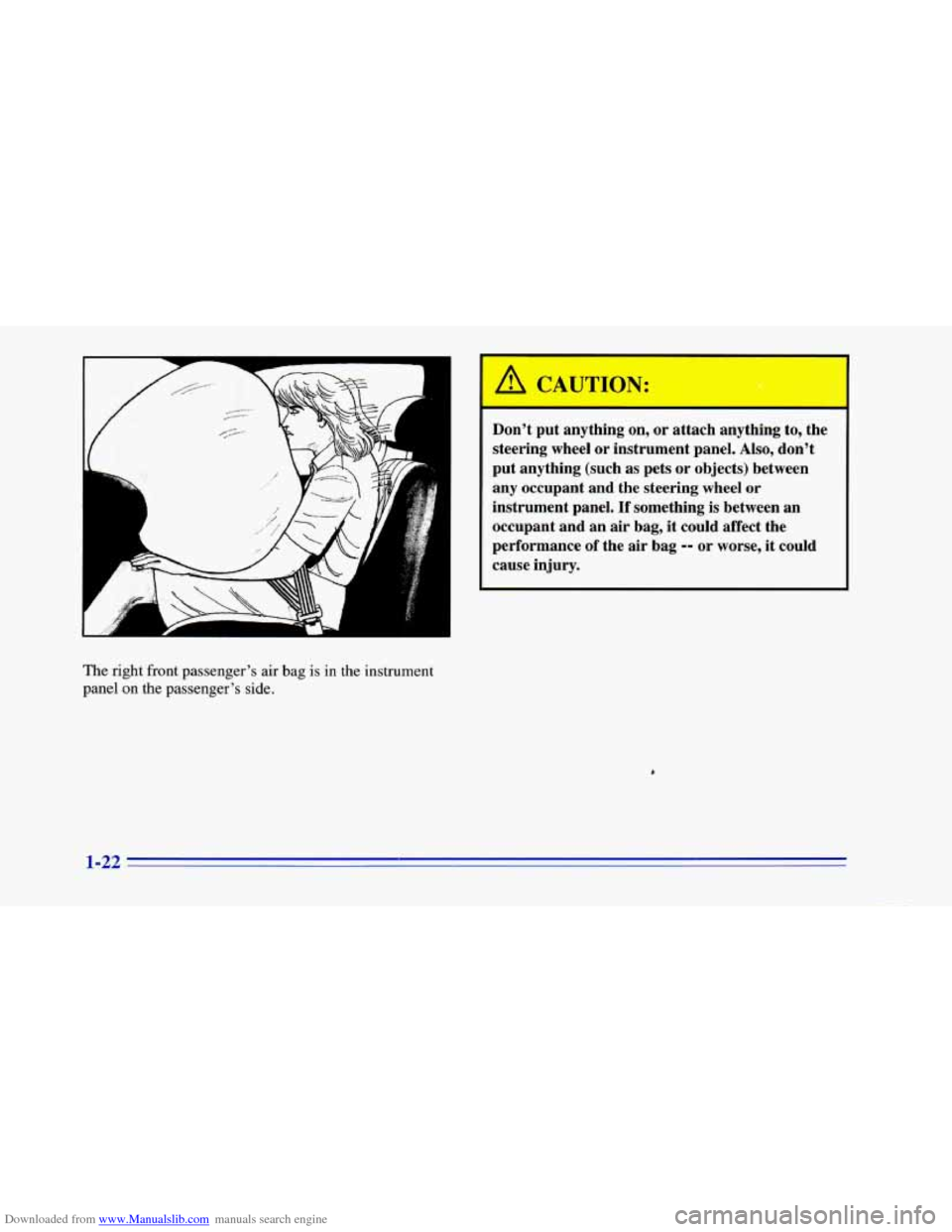
Downloaded from www.Manualslib.com manuals search engine I p-
The right front passenger’s air bag is in the instrument
panel on the passenger’s side.
I A CAUTION:
Don’t put anything on, or attach anything to, the
steering wheel or instrument panel.
Also, don’t
put anything (such as pets or objects) between
any occupant and the steering wheel or
instrument panel.
If something is between an
occupant and an air bag,
it could affect the
performance of the air bag
-- or worse, it could
cause injury.
I
1-22
Page 34 of 402
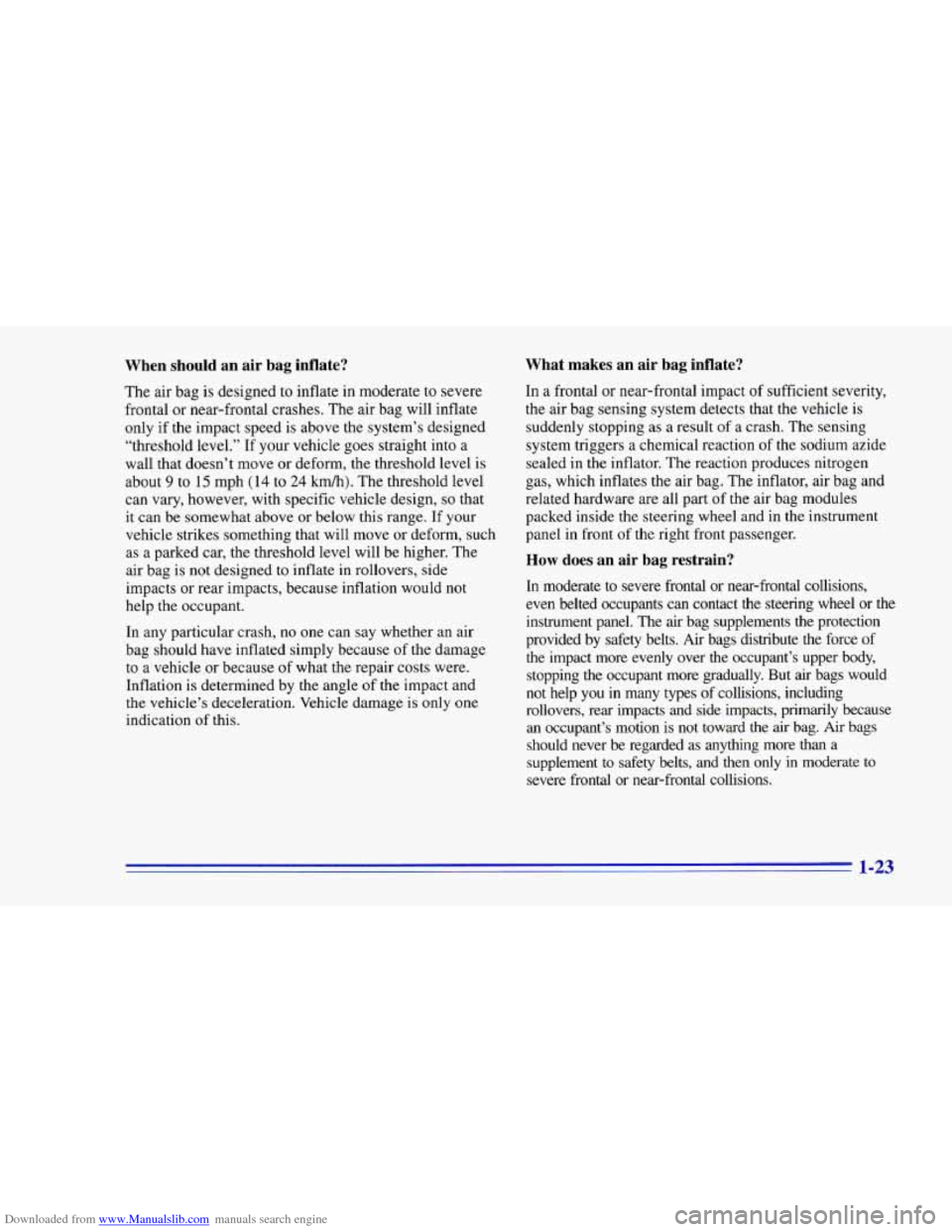
Downloaded from www.Manualslib.com manuals search engine When should an air bag inflate?
The air bag is designed to inflate in moderate to severe
frontal or near-frontal crashes. The air bag will inflate
only if the impact speed
is above the system’s designed
“threshold level.” If your vehicle goes straight into a
wall that doesn’t move or deform, the threshold level is
about
9 to 15 mph ( 14 to 24 km/h). The threshold level
can vary, however, with specific vehicle design,
so that
it can be somewhat above or below this range.
If your
vehicle strikes something that will move or deform, such
as a parked car, the threshold level will be higher. The
air bag is not designed to inflate in rollovers, side
impacts or rear impacts, because inflation would not
help the occupant.
In any particular crash,
no one can say whether an air
bag should have inflated simply because of the damage
to a vehicle or because of what the repair costs were.
Inflation
is determined by the angle of the impact and
the vehicle’s deceleration. Vehicle damage is only one
indication of this.
What makes an air bag inflate?
In a frontal or near-frontal impact of sufficient severity,
the air bag sensing system detects that the vehicle is
suddenly stopping as a result
of a crash. The sensing
system triggers
a chemical reaction of the sodium azide
sealed in the inflator. The reaction produces nitrogen
gas, which inflates the air bag. The inflator, air bag and
related hardware are all part
of the air bag modules
packed inside the steering wheel and in the instrument
panel in front of the right front passenger.
How does an air bag restrain?
In moderate to severe frontal or near-frontal collisions,
even belted occupants can contact
the steering wheel or the
instrument panel. The air bag supplements the protection
provided by safety belts. Air bags distribute the force
of
the impact more evenly over the occupant’s upper body,
stopping the occupant more gradually.
But air bags would
not help
you in many types of collisions, including
rollovers, rear impacts and side impacts, primarily because
an occupant’s motion is not toward the air bag. Air bags
should never be regarded as anything more than a
supplement to safety belts, and then only in moderate to
severe frontal or near-frontal collisions.
1-23
Page 35 of 402

Downloaded from www.Manualslib.com manuals search engine What will you see after an air bag inflates?
After the air bag inflates, it quickly deflates. This occurs
so quickly that some people may not even realize the air
bag inflated. Some components of the air bag module in
the steering wheel hub for the driver’s air bag, or the
instrument panel for the right front passenger’s bag, will
be hot for a
short time. The part of the bag that comes
into contact with you may be warm, but it will never be
too hot to touch. There will be some smoke and dust
coming from vents in the deflated air bags. Air bag
inflation will not prevent the driver from seeing or from
being able to steer the vehicle, norawill
it stop people
from leaving the vehicle. When an air bag
inflates, there is dust in the air.
This dust could cause breathing problems for
people with
a history of asthma or other
breathing trouble.
To avoid this, everyone in the
vehicle should get out as soon as it is safe to do
so.
If you have breathing problems but can’t get out
of the vehicle after an air bag inflates, then get
fresh air
by opening a window or door.
In many crashes severe enough to inflate an air bag,
windshields are broken by vehicle deformation.
Additional windshield breakage may also occur from the
right front passenger air bag.
0 The air bags are designed to inflate only once. After
they inflate, you’ll need some new parts for your air
bag system. If you don’t get them, the air bag system
won’t be there to help protect you in another crash.
A new system will include air bag modules and
possibly other parts. The service manual for
your
vehicle covers the need to replace other parts.
1-24
Page 36 of 402
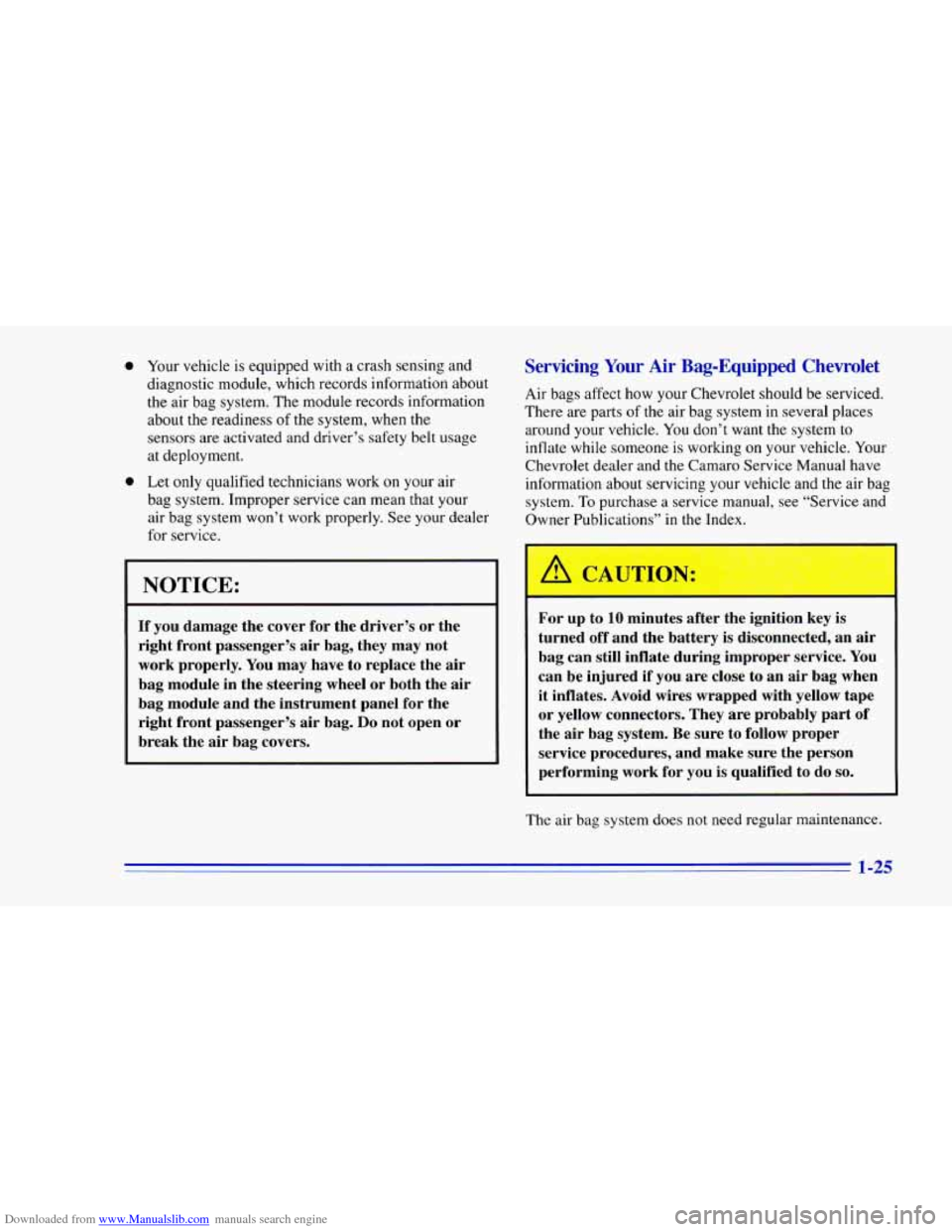
Downloaded from www.Manualslib.com manuals search engine 0
e
Your vehicle is equipped with a crash sensing and
diagnostic module, which records information about
the air bag system. The module records information
about the readiness of the system, when the
sensors are activated and driver’s safety belt usage
at deployment.
Let
only qualified technicians work on your air
bag system. Improper service can mean that your
air bag system won’t work properly. See your dealer
for service.
NOTICE:
If you damage the cover for the driver’s or the
right front passenger’s air bag, they may not
work properly. You may have
to replace the air
bag module in the steering wheel or both the air
bag module and the instrument panel for the
right front passenger’s air bag.
Do not open or
break the air bag covers.
Servicing Your Air Bag-Equipped Chevrolet
Air bags affect how your Chevrolet should be serviced.
There are parts of the air bag system in several places
around your vehicle.
You don’t want the system to
inflate while someone is working on your vehicle. Your
Chevrolet dealer and the Camaro Service Manual have
information about servicing your vehicle and the air bag
system.
To purchase a service manual, see “Service and
Owner Publications” in the Index.
I
For up to 10 minutes after the ignition key is
turned off and the battery is disconnected, an air
bag can still inflate during improper service. You
can be injured if you are close to
an air bag when
it inflates. Avoid wires wrapped with yellow tape
or yellow connectors. They are probably part of
the air bag system. Be sure to follow proper
service procedures, and make sure the person
performing work for you is qualified to do
so.
The air bag system does not need regular maintenance.
1-25
Page 56 of 402
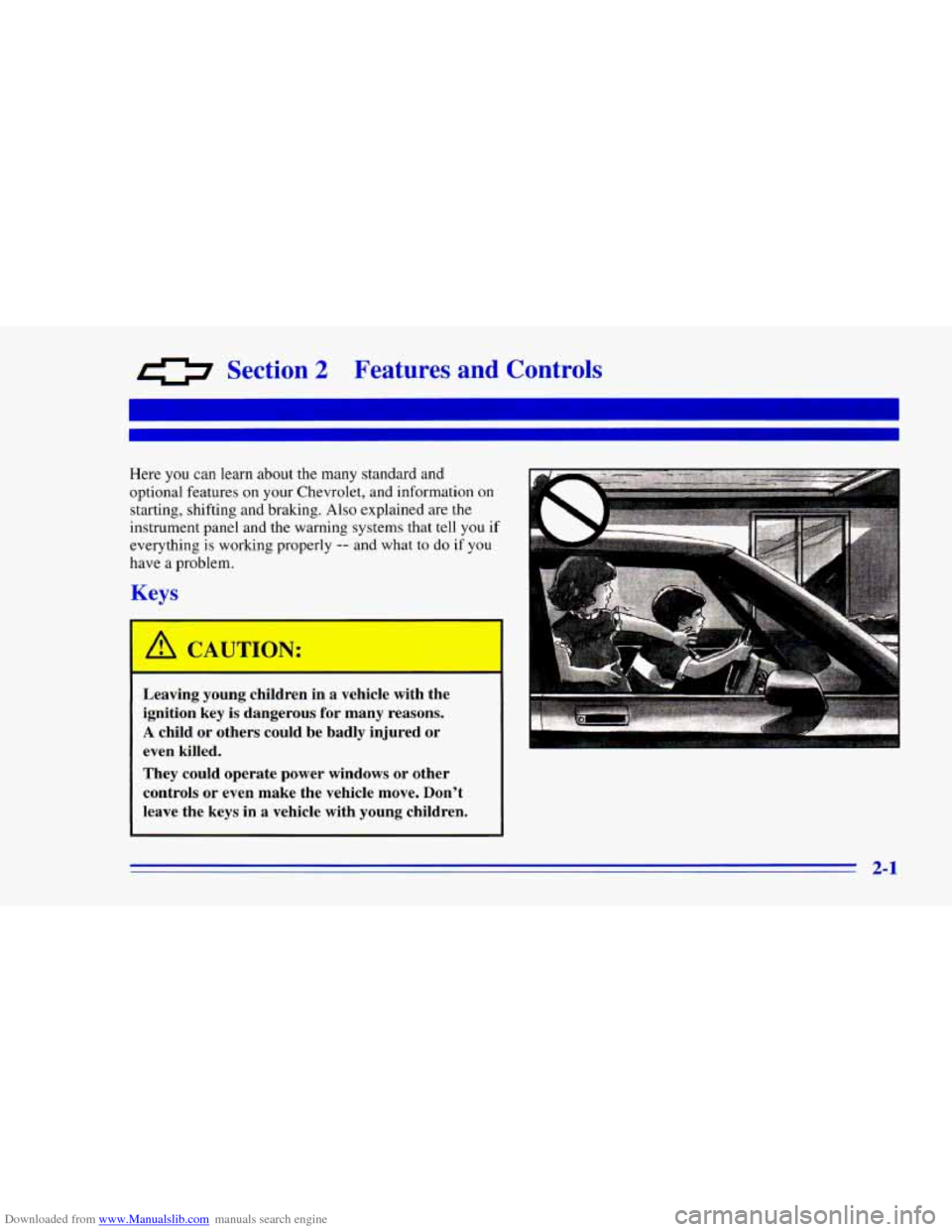
Downloaded from www.Manualslib.com manuals search engine 0 Section 2 Features and Controls
Here you can learn about the many standard and
optional features on your Chevrolet, and information on
starting, shifting and braking. Also explained are the
instrument panel and the warning systems that tell
you if
everything
is working properly -- and what to do if you
have a problem.
K-ys
Leaving young children in a vehicle with the
ignition key is dangerous for many reasons.
A child or others could be badly injured or
even killed.
They could operate power windows or other
controls or even make the vehicle move. Don't
leave the keys in a vehicle with young children.
31
Page 63 of 402
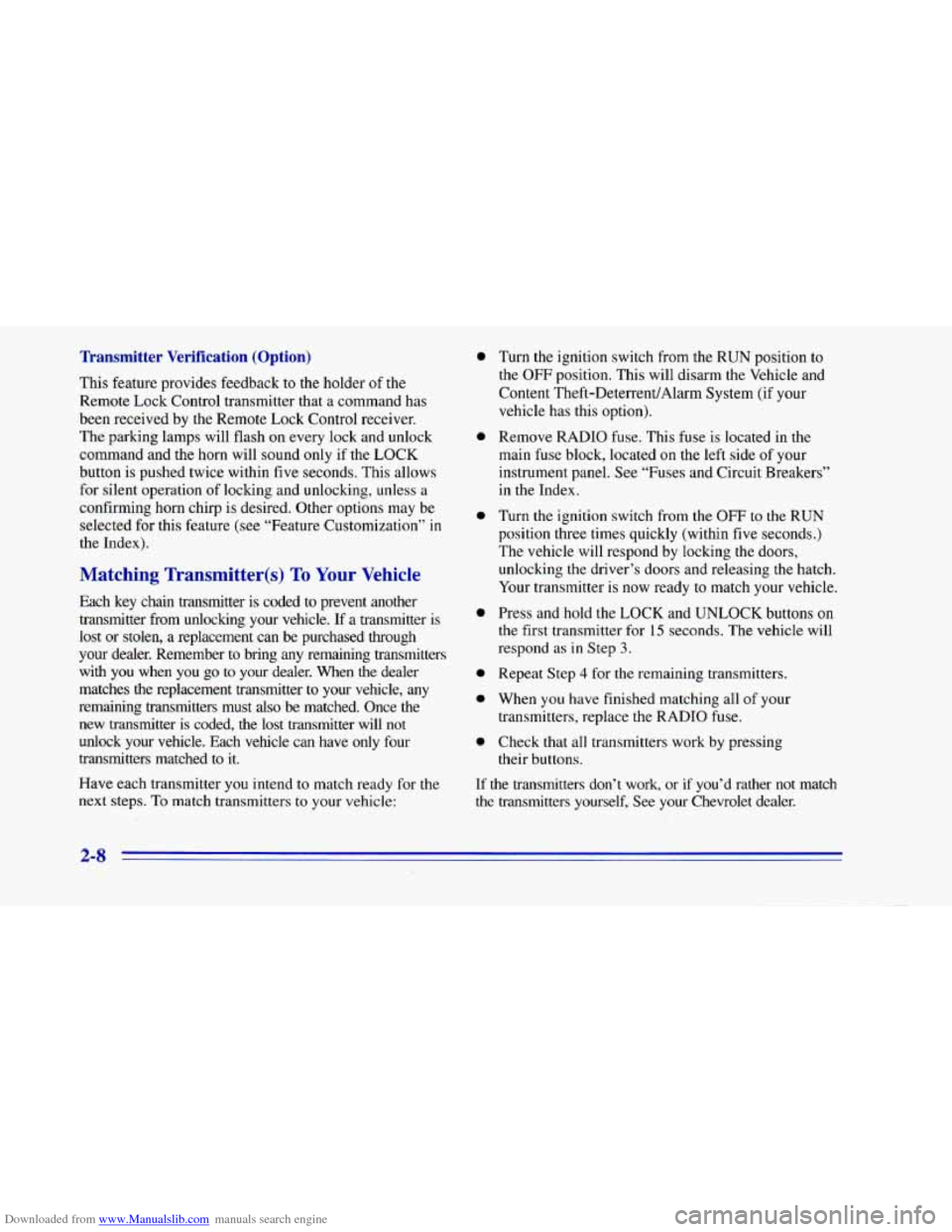
Downloaded from www.Manualslib.com manuals search engine Transmitter Verification (Option)
This feature provides feedback to the holder of the
Remote Lock Control transmitter that a command has
been received by the Remote Lock Control receiver.
The parking lamps will flash
on every lock and unlock
command and the horn will sound only if the LOCK
button is pushed twice within five seconds. This allows
for silent operation of locking and unlocking, unless a
confirming horn chirp is desired. Other options may be
selected for this feature (see “Feature Customization” in
the Index).
Matching Transmitter@) To Your Vehicle
Each key chain transmitter is coded to prevent another
transmitter from unlocking your vehicle. If
a transmitter is
lost or stolen, a replacement can be purchased through
your dealer. Remember to bring any remaining transmitters
with you when you go
to your dealer. When the dealer
matches the replacement transmitter to your vehicle, any
remaining transmitters must
also be matched. Once the
new transmitter is coded, the lost transmitter will not
unlock your vehicle. Each vehicle can have only four
transmitters matched
to it.
Have each transmitter you intend to match ready for the
next steps. To match transmitters to your vehicle:
0
0
0
0
0
0
0
Turn the ignition switch from the RUN position to
the OFF position. This will disarm the Vehicle and
Content Theft-Deterrent/Alarm System (if your
vehicle has this option).
Remove RADIO fuse. This fuse is located in the
main fuse block, located
on the left side of your
instrument panel. See “Fuses and Circuit Breakers”
in the Index.
Turn the ignition switch from the OFF
to the RUN
position three times quickly (within five seconds.)
The vehicle will respond by locking the doors,
unlocking the driver’s doors and releasing the hatch.
Your transmitter is now ready to match your vehicle.
Press and hold the LOCK and UNLOCK buttons
on
the first transmitter for 15 seconds. The vehicle will
respond as
in Step 3.
Repeat Step 4 for the remaining transmitters.
When you have finished matching all of your
transmitters, replace the RADIO fuse.
Check that all transmitters work by pressing
their buttons.
If the transmitters don’t work, or if you’d rather not match
the transmitters yourself, See your Chevrolet dealer.
2-8
Page 65 of 402
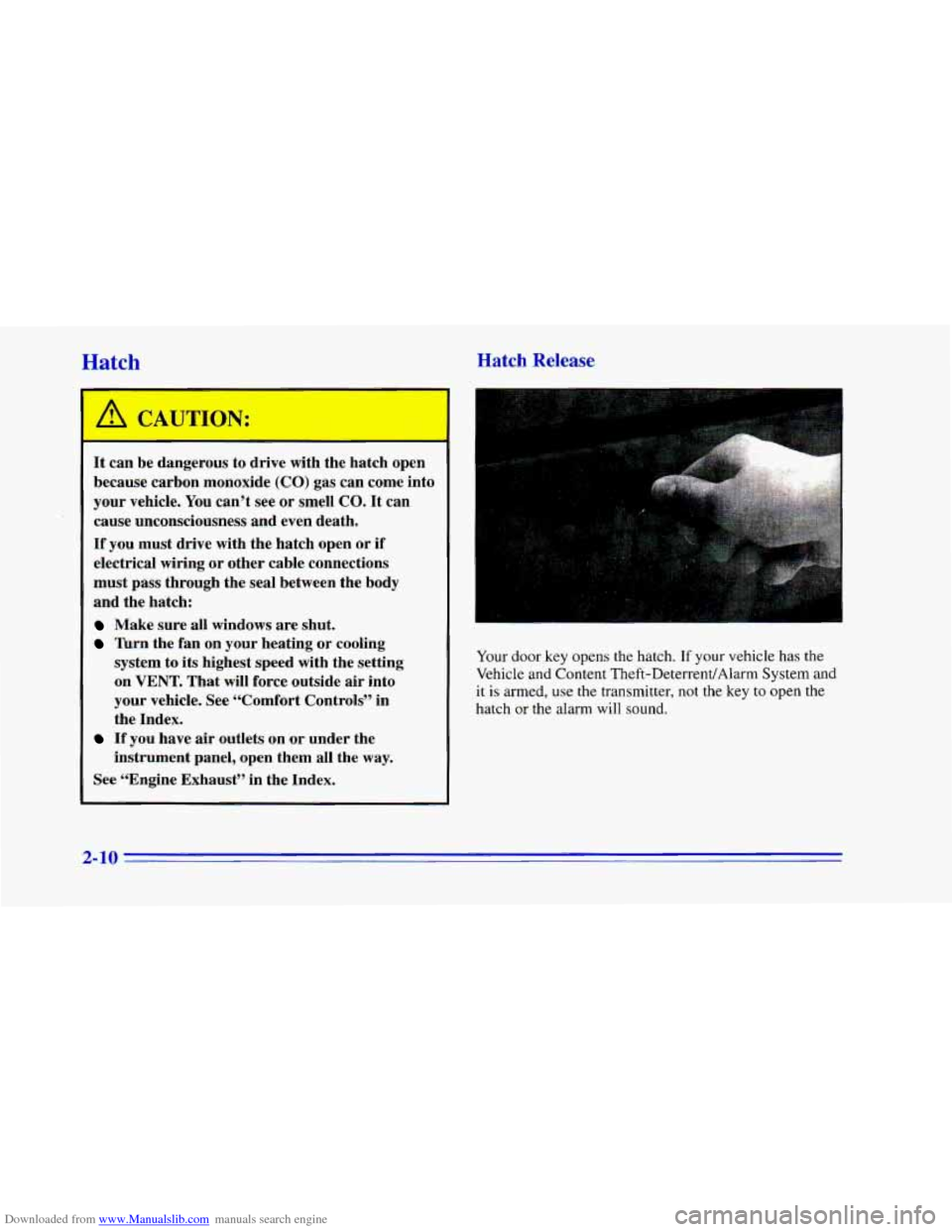
Downloaded from www.Manualslib.com manuals search engine Hatch Release
It can be dangerous to drive with the hatch open
because carbon monoxide (CO) gas can come into
your vehicle. You can’t see or smell CO. It can
cause unconsciousness and even death.
If you must drive with the hatch open or if
electrical wiring or other cable connections
must pass through the seal between the body
and the hatch:
Make sure all windows are shut.
’hrn the fan on your heating or cooling
system to its highest speed with the setting
on
VENT. That will force outside air into
your vehicle. See “Comfort Controls’’ in
the Index.
instrument panel, open them all the
way.
If you have air outlets on or under the
See “Engine Exhaust” in the Index.
.
Your door key opens the hatch. If your vehicle has the
Vehicle and Content Theft-Deterrent/Alarm System
and
it is armed, use the transmitter, not the key to open the
hatch
or the alarm will sound.
2-10
Page 72 of 402
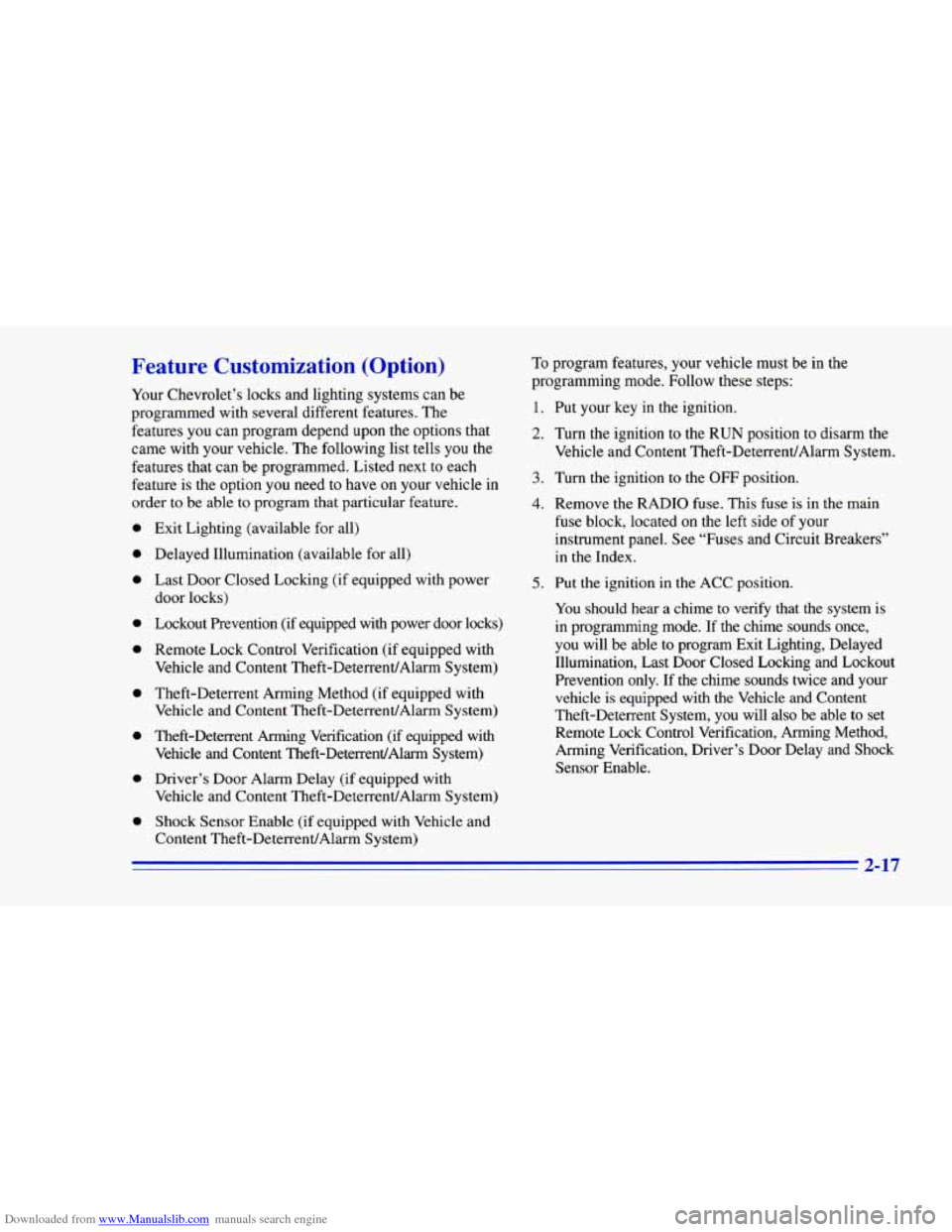
Downloaded from www.Manualslib.com manuals search engine Feature Customization (Option)
Your Chevrolet’s locks and lighting systems can be
programmed with several different features. The
features you can program depend upon the options that
came with your vehicle. The following list tells
you the
features that can be programmed. Listed next
to each
feature
is the option you need to have on your vehicle in
order
to be able to program that particular feature.
0
0
0
0
0
0
0
0
0
Exit Lighting (available for all)
Delayed Illumination (available for all)
Last Door Closed Locking (if equipped with power
door locks)
Lockout Prevention (if equipped with power door locks)
Remote Lock Control Verification (if equipped with
Vehicle and Content Theft-Deterrent/Alarm System)
Theft-Deterrent Arming Method (if equipped with
Vehicle and Content Theft-Deterrent/Alarm System)
Theft-Deterrent Arming Verification (if equipped with Vehicle and Content Theft-DeterrendAlarm System)
Driver’s Door Alarm Delay (if equipped with
Vehicle and Content Theft-DeterrentIAlarm System)
Shock Sensor Enable
(if equipped with Vehicle and
Content Theft-Detement/Alarm System) To
program features, your vehicle must be in the
programming mode. Follow these steps:
1. Put your key in the ignition.
2. Turn the ignition to the RUN position to disarm the
Vehicle and Content Theft-Deterrent/Alarm System.
3. Turn the ignition to the OFF position.
4. Remove the RADIO fuse. This fuse is in the main
fuse block, located on the left side
of your
instrument panel.
See “Fuses and Circuit Breakers’’
in the Index.
5. Put the ignition in the ACC position.
You should hear a chime
to verify that the system is
in programming mode. If the chime sounds once,
you will be able to program Exit Lighting, Delayed
Illumination, Last Door Closed Locking and Lockout
Prevention only. If the chime sounds twice and your
vehicle is equipped with the Vehicle and Content
Theft-Deterrent System, you will also be able to set
Remote Lock Control Verification, Arming Method,
Arming Verification, Driver’s Door Delay and Shock
Sensor Enable.
3-1 7